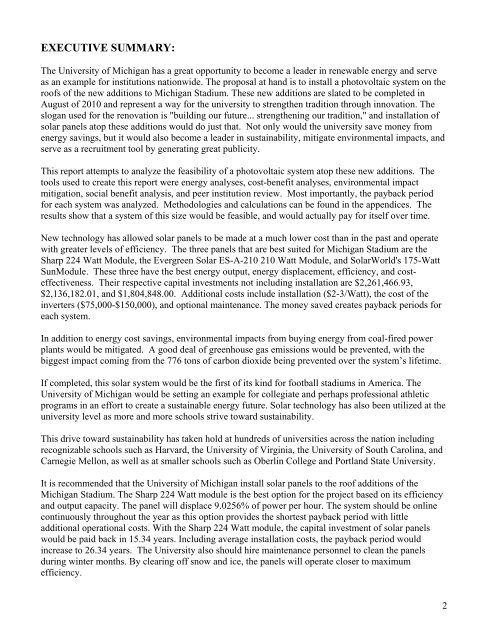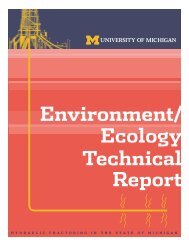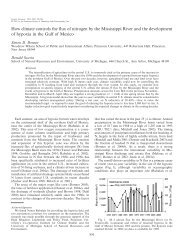2009report-solarstad.. - Graham Sustainability Institute - University ...
2009report-solarstad.. - Graham Sustainability Institute - University ...
2009report-solarstad.. - Graham Sustainability Institute - University ...
Create successful ePaper yourself
Turn your PDF publications into a flip-book with our unique Google optimized e-Paper software.
EXECUTIVE SUMMARY:The <strong>University</strong> of Michigan has a great opportunity to become a leader in renewable energy and serveas an example for institutions nationwide. The proposal at hand is to install a photovoltaic system on theroofs of the new additions to Michigan Stadium. These new additions are slated to be completed inAugust of 2010 and represent a way for the university to strengthen tradition through innovation. Theslogan used for the renovation is "building our future... strengthening our tradition," and installation ofsolar panels atop these additions would do just that. Not only would the university save money fromenergy savings, but it would also become a leader in sustainability, mitigate environmental impacts, andserve as a recruitment tool by generating great publicity.This report attempts to analyze the feasibility of a photovoltaic system atop these new additions. Thetools used to create this report were energy analyses, cost-benefit analyses, environmental impactmitigation, social benefit analysis, and peer institution review. Most importantly, the payback periodfor each system was analyzed. Methodologies and calculations can be found in the appendices. Theresults show that a system of this size would be feasible, and would actually pay for itself over time.New technology has allowed solar panels to be made at a much lower cost than in the past and operatewith greater levels of efficiency. The three panels that are best suited for Michigan Stadium are theSharp 224 Watt Module, the Evergreen Solar ES-A-210 210 Watt Module, and SolarWorld's 175-WattSunModule. These three have the best energy output, energy displacement, efficiency, and costeffectiveness.Their respective capital investments not including installation are $2,261,466.93,$2,136,182.01, and $1,804,848.00. Additional costs include installation ($2-3/Watt), the cost of theinverters ($75,000-$150,000), and optional maintenance. The money saved creates payback periods foreach system.In addition to energy cost savings, environmental impacts from buying energy from coal-fired powerplants would be mitigated. A good deal of greenhouse gas emissions would be prevented, with thebiggest impact coming from the 776 tons of carbon dioxide being prevented over the system’s lifetime.If completed, this solar system would be the first of its kind for football stadiums in America. The<strong>University</strong> of Michigan would be setting an example for collegiate and perhaps professional athleticprograms in an effort to create a sustainable energy future. Solar technology has also been utilized at theuniversity level as more and more schools strive toward sustainability.This drive toward sustainability has taken hold at hundreds of universities across the nation includingrecognizable schools such as Harvard, the <strong>University</strong> of Virginia, the <strong>University</strong> of South Carolina, andCarnegie Mellon, as well as at smaller schools such as Oberlin College and Portland State <strong>University</strong>.It is recommended that the <strong>University</strong> of Michigan install solar panels to the roof additions of theMichigan Stadium. The Sharp 224 Watt module is the best option for the project based on its efficiencyand output capacity. The panel will displace 9.0256% of power per hour. The system should be onlinecontinuously throughout the year as this option provides the shortest payback period with littleadditional operational costs. With the Sharp 224 Watt module, the capital investment of solar panelswould be paid back in 15.34 years. Including average installation costs, the payback period wouldincrease to 26.34 years. The <strong>University</strong> also should hire maintenance personnel to clean the panelsduring winter months. By clearing off snow and ice, the panels will operate closer to maximumefficiency.2










